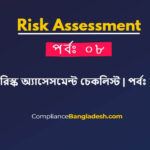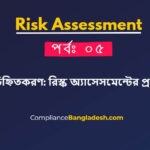Amfori BSCI Audit Checklist – 2022
Performance Area -01
- Auditee’s business license.
- Job descriptions (particularly of those positions directly related to the implementation of amfori BSCI Code of Conduct).
- Production capacity planning documentary evidence.
- Records on the amfori BSCI Code of Conduct and Terms of Implementation distribution and signature of significant business partners or members. This may also include farms.
- Evidence of business partners’ social performance (e.g. quarterly reports, audit reports, valid certificates).
- Qualifications of the person in charge of implementing amfori BSCI Code of Conduct.
- Documented policies and procedures to implement amfori BSCI Code of Conduct
- Producer Organization list of members.
Performance Area -02
- Documentary evidence of the workers representative election.
- Documentary evidence of regularly scheduled workers meetings.
- Records of agreements with workers representatives.
- Employment contracts including those related to security personnel, cleaning and other services, particularly recruiting agencies or brokers if relevant.
- Job descriptions in which the implementation of amfori BSCI Code of Conduct is included.
- Working rules.
- Evidence of a training calendar for workers and management.
- Documentary evidence of training given to workers, management and human resources (e.g. list of attendees with signatures).
- Documentary evidence of trainer competence.
- Documentary evidence of grievances lodged/investigated (e.g. amfori BSCI Template 8: Grievance Mechanism Tracker filled in
Performance Area -03
- Documentary evidence of the workers representative election.
- Collective Bargaining Agreement (if applicable).
- Minutes or documents of meetings that led to the collective bargaining agreement (if applicable).
- Recruitment and dismissal procedures and records.
Performance Area -04
- Documentary evidence on disciplinary procedures.
- Documentary evidence on disciplinary cases and the measures taken.
- Documentary evidence of workers’ performance assessments and procedures.
- Work contracts or agreements, including with recruitment agencies.
- Documentary evidence of grievances lodged/investigated (e.g. amfori BSCI Template 8: Grievance Mechanism Tracker filled in).
Performance Area -05
- Documentary evidence of legal deductions for goods and services.
- Documentation on legal minimum wages relevant for the sector.
- Documented collective bargaining agreement.
- Pay slips for workers and documentary evidence of payments.
- Fair remuneration quick-scan completed (amfori BSCI Template 5: Fair Remuneration Quick Scan).
- Auditee’s contracts with labour subcontractors and service providers including recruiting agencies or labour brokers.
- Work contracts or agreements, including those held by workers with labour subcontractors and service providers.
- Personnel data files for all workers (including seasonal workers).
- Documentary evidence of additional benefits (commercial insurance if applicable).
- Documentary evidence of updated contributions to social insurance funds.
- Lists of wage ranges and calculations including for piece rate workers.
Performance Area -06
- Documented working rules.
- Pay slips for workers and documentary evidence of payments.
- Documentary evidence of the legal permanent exception covering the auditee’s industry.
- Working time records.
- Documented overtime procedure including agreements with workers.
- Documented records of accidents.
Performance Area -07
Certificates and contracts:
- Valid inspection and insurance for machinery and vehicles.
- Purchase invoices of the PPE bought by the auditee.
- Valid business license and all necessary official approvals to run operations.
- Official building certificate about safety and appropriateness for the industry.
- Contract with any service provider including food services, transportation, agents.
Training:
- Documentary evidence of workers training on occupational health and safety.
- Documentary evidence of training, consultations and informative sessions held for members of a producer organization.
- Workers and management training calendar.
- Documentary evidence of workers qualification for those dealing with dangerous. machines, electrical installation and any other activity that requires specific training due to the level of risk.
Records and reports:
- Risk assessment for safe, healthy and hygienic working conditions.
- Action plan for safe, healthy and hygienic working conditions.
- Documentary evidence of updated contributions to social insurance funds.
- Occupational health and safety regulations applicable for the industry.
- Documentary evidence of the election process of the health and safety committee.
- Minutes of the health and safety committee meetings.
- Documentary evidence of consumption, withdrawal and disposal of chemicals (including Material Safety Data Sheets – MSDS).
- Official inspections conducted to ensure building and equipment safety, including date of validity and corrective actions if any.
- Inspection reports, maintenance records, operating and safety instructions for: Dangerous machines, including but not limited to lifts, electrical equipment, high-pressure equipment o Firefighting equipment (e.g. inspection tags on fire extinguishers) o Potable water at production facilities and dormitories o Health and safety for the facilities and dormitories including but not limited to temperature, noise level and lighting.
Performance Area -08
- Personnel data files for all workers (including seasonal workers and workers hired using recruitment agencies).
- Age-verification procedure.
- Documentary evidence of training given to workers, management and human resources (e.g. list of attendees with signatures)
- Procedure to avoid children exploitation.
- Child labour remediation procedure.
- Work contracts or agreements, including with recruitment agencies.
Performance Area -09
- Documentation of all trainings given to young workers.
- Risk assessment and related action plan with specific measures to protect young workers and young female workers.
- Young workers overview records.
- Young workers’ work cycle overview.
Performance Area -10
- Employment contracts and/or posters where workers’ rights and obligations are displayed.
- Recruitment and dismissal procedures and records.
- Overview of subcontractors.
- Overview of apprenticeships granted in the company.
- Overview of seasonal workers.
Performance Area -11
- Documentary evidence of trainings given to workers, management and human resources (e.g. list of attendees with signatures).
- Documentary evidence on disciplinary procedures.
- Employment contracts including those related to security personnel, cleaning and other services.
- Documentary evidence on disciplinary cases and measures taken.
Performance Area -12
- Environmental risk / impact assessment.
- Map identification of water springs, rivers, lakes in the area of auditee activities.
- Calculation of the necessary financial and personnel resources to comply with the minimum social and environmental requirements.
- Valid certificates and environmental licenses.
- Waste management plan.
- Water management plan.
- Environmental Management policies and procedures.
Performance Area -13
- Business license.
- Anti-corruption policy.
- Corruption risk assessment.
- Procedure for investigation and discouragement of unethical behavior.
- Communications and trainings to promote and reward integrity.











Recent Comments